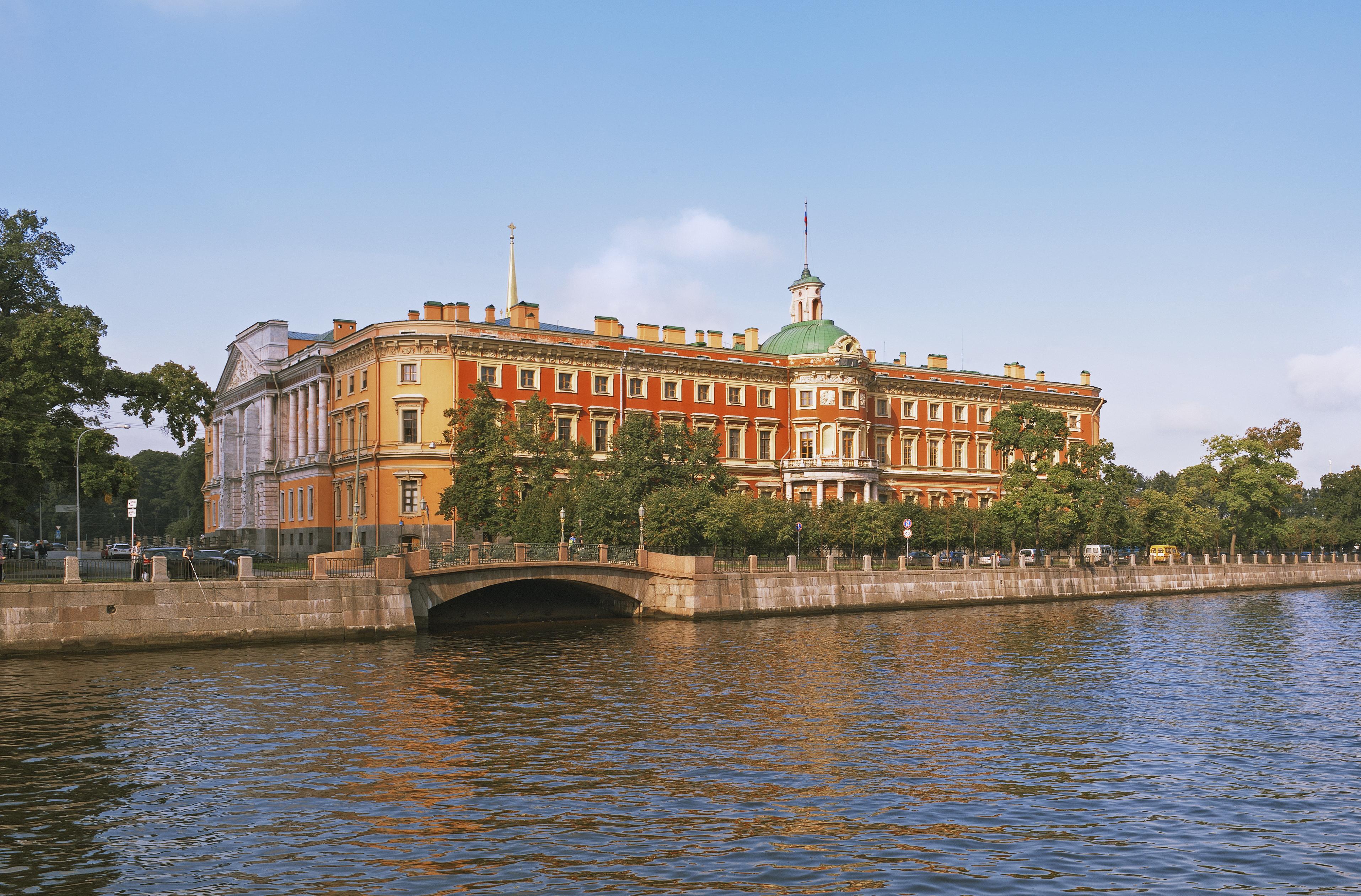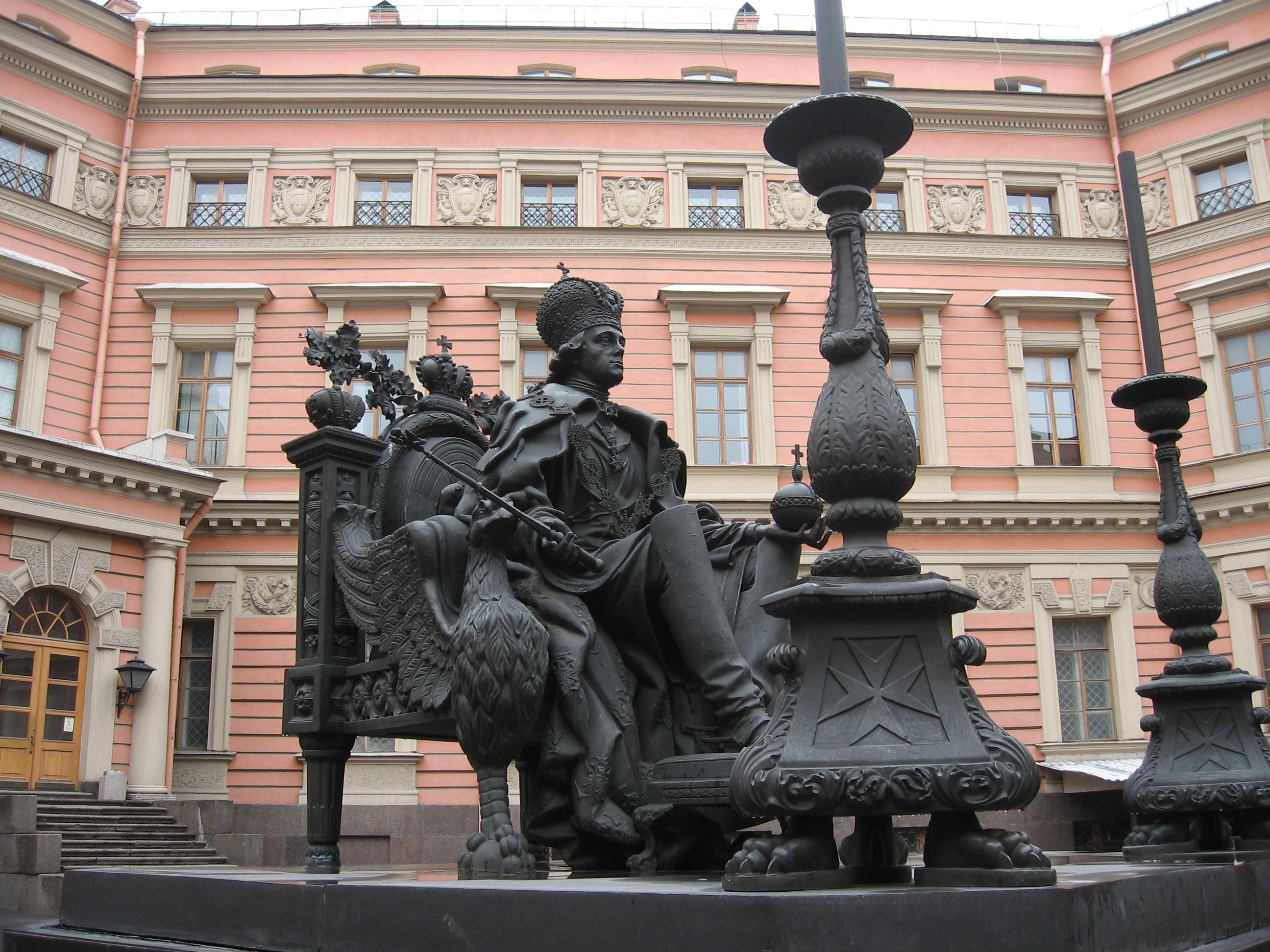Mikhailovsky Castle [Saint-Petersburg]
Mikhailovsky Castle/Михайловский замок
Описание
Mikhailovsky Castle is a great architectural monument and the culmination in the history of St Petersburg architecture of the XVIII century. It was erected on the site of the Summer Palace of Empress Elizaveta Petrovna (architect Rastrelli, 1740s), which was dismantled by order of Emperor Pavel I after the death of his mother — Catherine II. The original idea of the castle belonged to Pavel himself and the first sketches were made by him. The construction of his future residence started in 1784. During the construction, which took almost 12 years, the Grand Duke referred to various architectural monuments that he had seen on his trip abroad in 1781-1782. Several architects worked on the project at different stages — H.-F.-G. Viollier, V. Brenna, V.I. Bazhenov. One of the potential sites for the new palace was Gatchina.
Catherine II’s son only managed to implement his plan after he came to the throne in November 1796. A solemn ceremony of laying the foundation of the castle took place on February 28, 1797. The construction was managed by architect Brenna, who amended the original project and designed the interiors. On November 8, 1800, on the day of Saint Archangel Mikhail, the castle was consecrated, however, the work on its interiors continued until March 1801.
Distinctive design of the building, combining conflicting architectural trends and stylistic features, makes it stand out in the history of Russian Classicism. However, it is Mikhailovsky Castle that is considered to be the most significant symbol of Pavel’s era, clearly reflecting the artistic taste and the peculiar personality of its owner and principal creator — Emperor Pavel I. The immense size of the “palace of Saint Mikhail” (as the castle was referred to in the documents of the XVIII century), dominated the island lapped by the waters of the Moika and the Fontanka rivers from the northern and the eastern sides. On the western and the southern sides there were two specially dug canals — Resurrection Canal and Church Canal. The system of the castle fortifications, surrounding the palace and Connetable Square in front of it, included canals, demi-bastions, drawbridges and cannons. In the centre of the square was a monument to Peter I, designed in 1745-1747 after a model by B.C. Rastrelli made in the lifetime of the outstanding great-grandfather of Pavel I.
Mikhailovsky Castle was the Emperor’s residence only for 40 days. On the night of March 12, 1801, Emperor Pavel I was assassinated in his bedroom, falling victim to a palace coup. Soon after, all valuables were transferred from the castle, and the state rooms were used by different administrative institutions some were even turned into apartments.
In the early 1820s the building was handed over to the Central College of Engineering. In February 1823 it was named Engineers’ Castle. After the death of Emperor Nicholas I, the patron of the college, the institution became known as Nicholaevsky Academy and College of Engineering. Many prominent Russians were lecturers or graduates of this academy, among them: writers F.M. Dostoevsky and D.V. Grigorovich, scientists I.M. Sechenov and P.N. Yablochkov, composer T.A.Kui, the hero of the Sebastopol War E.I. Totleben, and many others.
For two centuries, as the building accommodated military and academic institutions (and, later, different Soviet institutions), the layout of the ensemble was changed multiple times, with structures rebuilt and interiors redesigned.
In 1991 Mikhailovsky Castle became part of the State Russian Museum.
Architecture and interiors
The palace design is centred around a square with rounded corners, with a rectangle of the ceremonial courtyard inside. Each facade has its own “face”, making the building particularly picturesque and allowing a diversity of views from different angles. Despite that, the palace produces an integral impression due to the common granite plinth, cornice, and uniform decorative elements.
The main facade is particularly solemn and monumental. A powerful element of its design are two marble obelisks decorated with military symbols and gilt monograms of Pavel I. There is a bas-relief in the tympanum of the pediment called “History noting down the glory of Russia in its records”, designed by the Stagi brothers. There is an inscription on the cornice above the pediment which is a variation on the last lines of Psalm 92 in the Bible: “Your house will flourish in the courts of our God”.
The northern facade facing the Summer Garden has a completely different design. Its sculptural decoration, a wide gently rising staircase, the colonnade and the balcony are traditional elements of a facade overlooking the garden, referring to its connection with nature.
The eastern facade overlooking the Fontanka has a semi-circular protrusion in the wall, topped by a steepled turret complete with flagpole, which flew the imperial banner signifying Pavel I’s presence in the castle. Its modest design matches the facades of the “particular” houses on the opposite bank of the Fontanka.
The design of the western (church) facade particularly reflects architect Brenna’s talent for abundant and spectacular decoration, which attracted Pavel. The church’s straight lines are interrupted by a large protrusion in the centre of the wall, and the sculptural decoration signifies the religious role of this structure.
The interiors of Mikhailovsky Castle were referred to by contemporaries as “the epitome of luxury and taste”. Among the designers were monumental painters P., C. and J. Scotti, A. Vigi, J. Mettenleiter, sculptors C. Albani, I.P. Prokofiev, P.I. Sokolov, artists I.A. Akimov, A.M. Ivanov, and others. Similarly to many other palaces of the aristocracy of that time, the castle served both the main residence of the royal family and as an art gallery accommodating collections of Ancient, Western- European and Russia art. The suite of state rooms, comprising the Antique Room, Rafael’s Gallery, Laocoon Gallery, and the Arabesque Gallery, were located along the perimeter of the courtyard and accommodated world class works of art from Pavel I’s collection. Many elements of interior design were based on sketches by Vincenzo Brenna and his young apprentice Carlo Rossi.
Источник информации: The State Russian Museum
Адрес: Sadovaya St., 2, St. Petersburg 191011, Russia
Телефон(ы): 8 (812) 595-42-48
Достопримечательности рядом
Отзывы на ««Mikhailovsky Castle»» (Saint-Petersburg)
Общий рейтинг Гугл (4.6, всего отзывов: 5241). Ниже приведено несколько последних отзывов, полученных от Гугла.
Очень красивое и приятное место, вопреки своей жуткой истории. Красивые величественные залы, предметы искусства, в двух залах показывают фильмы об истории самого замка, летнего сада, портрета Павла I. В отдельном зале представлена инсталляция, рассказывающая о частной жизни императорской семьи, звучат голоса царевен и царевичей. В одном месте фильм крутится нонстоп, можно начать и закончить просмотр в любом месте, сидя на удобных диванах. В другом зале фильм нужно выбрать и включить самостоятельно. Малолюдно.
Замок, хранящий императорские тайны, и превратившийся в музей! Красивые интерьеры, портреты императорской семьи, скульптуры...Лучше брать экскурсию, чтобы узнать в деталях об этом замке, экспозиции и недорогой жизни императора в его стенах. Недавно открылась для посещения домовая церковь внутри замка, которая была закрыта 30 лет! Ее стоит посетить! А также нынешнюю выставку "Валаам. 200 лет в русской живописи".
Замок, где жили императоры России, многое осмысливаешь по другому, когда гуляешь по его залам. Очень много выставок, нам посчастливилось побывать на выставке, посвящённлй Николаю второму. К посещению гостям города - обязательно. Лучше посещать с гидом-экскурсоводом.
Красиво, эпично, все понятно. Но Боги на выставку - 400 рублей. Я вот с ребёнком пошла на экспозицию, посвящённую двухсотлетию открытия Антарктиды. Экспозиция, сказать беленькая, это ничего не сказать. Слезы. Я понимаю, что по этому билету можно и другие выставки посмотреть, но с ребёнком это не возможно. И что? Я за почти пол тысячи посмотрела бедненькую такую выставочку. И это - в СПб. Где историю открытия и освоения полярных регионов можно всю жизнь изучать. Странненько...
В целом неплохо. Но экспозиция небольшая, часть закрыта помещений видимо на реконструкцию. Кто любит портретистов можно посетить. Но я ожидал большего. Света нехватает в помещении, многие картины смотреть неудобно, так как они бликуют.
Что посмотреть in Saint-Petersburg
Дворцы, замки, усадьбы, дома
- Admiralty building
- Alexander Palace
- Anichkov Palace
- Beloselsky-Belozersky Palace
- Catherine Palace
- Constantine Palace
- Cottage Palace
- Derzhavin Estate Museum
- Gatchina Palace
- Marble Palace
- Mariinsky Palace
- Menshikov Palace
- Menshikov's Great Palace
- Mikhailovsky Castle
- Pavlovsk Palace
- Peterhof Grand Palace
- Shlisselburg (Oreshek) Fortress
- Stroganov Palace
- Summer Palace of Peter the Great
- Tauride Palace
- Vorontsov Palace
- Yelagin Palace
- Yusupov Palace
- Zinger Company House
Исторические места
Мосты
- Anichkov Bridge
- Bank Bridge
- Blue Bridge
- Bolsheokhtinsky Bridge
- Bridge of Four Lions
- Egyptian Bridge
- Potseluev Bridge
- Stone Bridge
Музеи
- A.S. Popov Central Museum of Communications
- Alexander Blok Apartment Museum
- Anna Akhmatova Literary and Memorial Museum
- Arkhip Kuindzhi's Apartment Museum
- Central Naval Museum
- Chaliapin House Museum
- Dostoevsky Museum
- Erarta
- Fabergé Museum
- Freud Museum of Dreams
- Grand Maket Rossiya
- Icebreaker Krasin
- Kunstkamera
- LabyrinthUm Museum
- Loft Project Floors Exhibition Hall
- Microminiature museum
- Military Historical Museum of Artillery, Engineers and Signal Corps
- Museum of Political History of Russia
- Narodovolets D-2 Submarine Museum
- Nekrasov Memorial Museum-Apartment
- Penates, I. Y. Repin's Estate Museum
- Peter I House
- Peter the Great Botanical Garden
- Petrovskaya Aquatoria, Scale Model
- Pushkin Museum and Memorial Apartment
- Rimsky-Korsakov Apartment and Museum
- Russian Museum
- Russian State Museum of Arctic and Antarctic
- Russian Vodka Museum
- Saint Isaac's Cathedral
- St. Petersburg State Museum of Theatrical and Musical Art
- State Hermitage Museum and Winter Palace
- State Memorial Museum of Leningrad Defense and Blockade
- Suvorov Museum
- The Museum of Lomonosov
- The Pushkin Country House Museum
- The State Museum of the History of St. Petersburg
- Tsarskoye Selo Lyceum
- Vladimir Nabokov Museum
- Vselennaya Vody Museum Complex
- Zoological Museum of the Zoological Institute of the Russian Academy of Sciences
Ночная жизнь, рестораны, кабаре
- Biblioteka
- Buddha-Bar
- Cafe Singer
- Club A2
- Coyote Ugly
- Gosti
- JFC Jazz Club
- Leningrad Center
- Makaronniki
- Old customs
- Retro Disco Club Papanin
- Terrassa
Памятники, скульптуры, статуи
- Bronze Horseman
- Egiptian Gates
- Monument to Nicholas I
- Monument to the Heroic Defenders of Leningrad
- Monument to the Nose of Major Kovalev
- Quay with Sphinxes
- Statue of Chizhik-Pyzhik
- The monument to Catherine II
Парки и природные достопримечательности
- Alexandrovsky Park
- Kirov Central Park of Culture and Recreation
- Leningrad Zoo
- Michael Garden
- Moskovsky Victory Park
- Peterhof. Lower park
- Summer Garden
- Tauride Garden
- The Park of the 300th anniversary
Площади, улицы, фонтаны, районы
Пляжи, аквапарки, купальни, бани, аквариумы
Спортивные сооружения
Театры и концертные залы
- Academical Maly Drama Theatre - Europe Theatre
- Akimov Comedy Theatre
- Alexandrinsky Theatre
- Hermitage Theatre
- Mariinsky Theatre
- Mikhaylovsky Theatre
- Saint Petersburg Philharmonia
- St. Petersburg Youth Theater on Fontanka
- Tovstonogov Bolshoi Drama Theater
Храмы, соборы, монастыри
- Alexander Nevsky Lavra
- Buddhist Temple
- Cathedral of Saints Peter and Paul
- Chapel of St. Xenia of St. Petersburg
- Church of the Savior on Blood
- Feodorovsky Cathedral
- Gothic Chapel
- Grand Choral Synagogue
- Kazan Cathedral
- Kronstadt Naval Cathedral
- Lutheran Church of St. Peter
- Peter and Paul Fortress
- Saint Petersburg Mosque
- Smolny Cathedral
- Sophia Cathedral
- Trinity Cathedral
- Vladimirskaya Church
Активный отдых, аттракционы, развлечения
- Bolshoi St Petersburg State Circus
- Divo Ostrov
- Dolphinarium
- Ice Palace
- Kidburg
- Piterland Aquapark
- Planetarium
Прочее
В списке обозначено:
- Топ-достопримечательности
- Для детей


